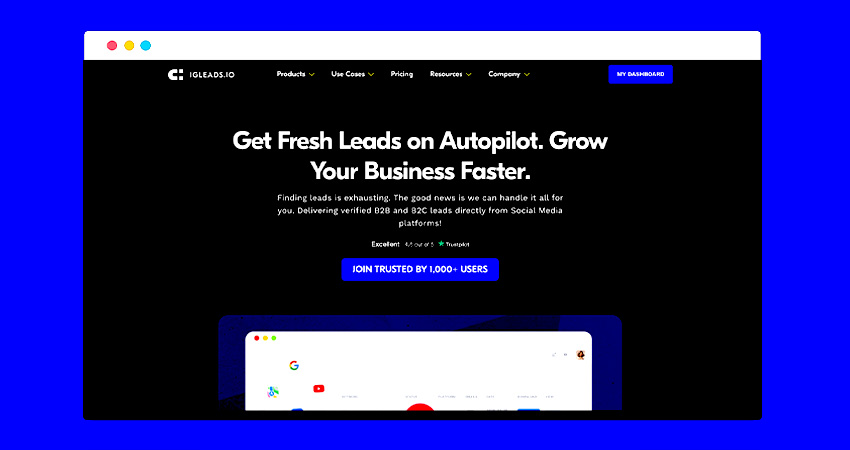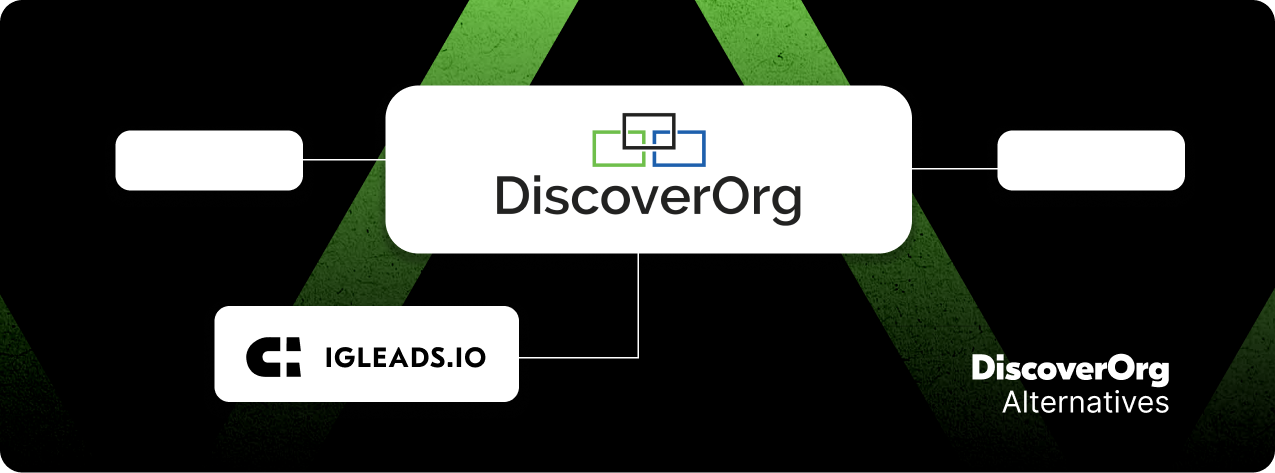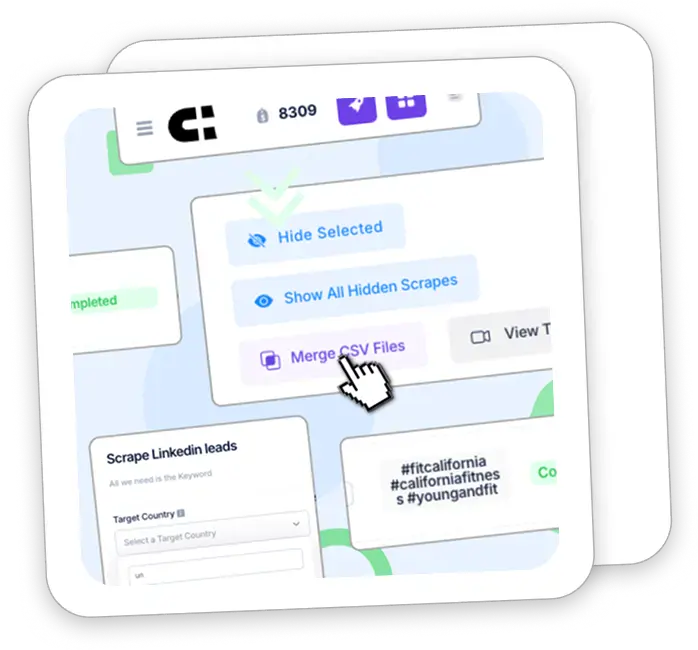Buy Email Lists for Marketing in 2025: Complete Guide to Business Leads

While marketers chase fleeting TikTok algorithms and Instagram’s latest feature changes, savvy businesses are quietly doubling their revenue using the oldest digital channel in existence. With average ROIs exceeding 36:1, the data is clear – but the rules have completely transformed this year. This guide reveals exactly how to leverage purchased email lists in today’s AI-powered ecosystem without wasting budget or damaging your sender reputation.
Most businesses that fail with purchased email lists do so for two reasons: they ignore compliance rules and they buy low-quality data that destroys deliverability. In this 2025 guide, we’ll cover compliance requirements, vendor vetting, ROI benchmarks, and real-world case examples so you can make an informed decision.
Did you know that IGLeads offers an email scraper tool that delivers thousands of emails in a few hours? It is one of the easiest ways to expand your email list with high-quality leads.
Why Email Lists Matter More Than Ever in 2025
In the chaos of building a business, whether you’re a scrappy solo founder or racing to scale, there’s one asset that quietly outperforms almost everything else: your email list.
Let’s be honest. It’s 2025, and we’ve all heard countless predictions about email’s demise. Yet here we are, watching email marketing consistently deliver the highest ROI of any digital channel. Why? Because while social platforms change algorithms overnight and ad costs climb relentlessly skyward, your email list remains entirely yours, giving you a direct line to people who’ve actually asked to hear from you.
Think about it: no middleman, no unpredictable reach, no rental fees, just you and your audience, having a conversation on your terms.
But there’s a catch. Not just any list will do. That outdated spreadsheet of contacts or those questionable purchased leads? They’re more of a liability than an asset. A truly valuable email list, one that drives real business growth, requires intention, nurturing, and the right approach.
In this guide, I’ll walk you through everything that works: building your list from scratch (yes, even if you’re starting at zero), automating growth with smart tools, navigating the minefield of purchased lists, and transforming casual subscribers into your most valuable customers.
Let’s turn your email list into the business engine it was meant to be.
What This Guide Will Cover
- How to build an email list manually
- How to build an email list using lead generation tools
- Buying email lists: when and how to do it
- Managing your email list for best results
- Tools comparison to help you choose the right solution
What is an Email List?
An email list is simply a collection of email addresses from people interested in your business, products, or content. These contacts have given you permission to reach out directly through newsletters, promotions, or personalized messages.
Don’t confuse an email list with email marketing platforms. Tools like Mailchimp or ActiveCampaign help you send and manage communications, but your email list is a valuable data asset that you actually own and control.
Importance of Email List Management
Building a list is just the beginning. Managing it effectively determines your success. Good list management practices ensure high deliverability rates, strong engagement, and better segmentation for personalized marketing.
Without proper management, your list can quickly become stale, leading to high bounce rates, unsubscribes, and potential blacklisting by email providers.
Where Email Lists Fit into the Broader Marketing Funnel
- Top of the Funnel (TOFU): Attract new subscribers with lead magnets and content.
- Middle of the Funnel (MOFU): Nurture leads with valuable content and education.
- Bottom of the Funnel (BOFU): Convert leads into customers through targeted offers and promotions.
How to Build an Email List Manually
Manual list building involves collecting emails through direct interaction, both online and offline. This approach gives you complete control over who enters your list and typically creates a high-quality, high-intent audience of people who genuinely want to hear from you.
Tactics
Newsletter Signups with Lead Magnets
Offer something valuable in exchange for an email. Lead magnets can include ebooks, discount codes, mini-courses, or early access to product launches. This method works best when aligned with your core offer or audience interest.
Website Forms
Install email capture forms across your site. Use them on your homepage, in blog posts, or as exit-intent popups. Make it clear what users are signing up for and why it’s worth their time.
Manual LinkedIn or Email Outreach
Reach out directly to prospects via LinkedIn or cold email. If done with personalization and value, this can lead to meaningful connections and organic list growth.
Tools to Support Manual Capture
- Typeform: For building interactive lead capture forms.
- Notion: To organize and track leads in a flexible workspace.
- Google Sheets: A simple way to log and manage contacts.
- Zapier: Automate sending new contacts from forms to your CRM or email platform.
Pros and Cons
Pros:
- High intent: Everyone on your list opted in for a reason.
- Personalized: Allows one-to-one connection before the opt-in.
- Cost-effective: No need to purchase tools or data.
Cons:
- Time-consuming: Manual outreach or data entry slows growth.
- Not scalable: You’ll quickly hit a ceiling without automation.
- Inconsistent: Depends heavily on your time and effort.
Who This Works Best For
Manual methods are best for solopreneurs, early-stage startups, and anyone testing a new idea or market. It’s a strong starting point for building a loyal base of subscribers before moving to scalable systems.
How to Build an Email List with Tools
If you’re serious about growth, manual collection won’t be enough. Lead generation tools give you the ability to collect emails at scale, with precision targeting and automation built in.
Best Tools to Generate Email Leads
| Tool | Key Features | Best For | Est. Monthly Price |
| IGLeads.io | Scrapes data from Instagram, LinkedIn, Google Maps. No-code interface. Compliance-focused. | B2B, local services, real estate | $59–$149 |
| Apollo.io | B2B database, verified contacts, sales sequences | Sales teams, SDRs | $39–$99 |
| Clay.run | Lead enrichment with AI, visual workflow builder | Agencies, automation-heavy teams | $149+ |
| Hunter.io | Email lookup by domain, bulk search capabilities | B2B outreach | $49+ |
| PhantomBuster | Automates social media data scraping and outreach | Growth marketers | $59–$139 |
| Octoparse | Custom web scraping with visual drag-and-drop | Technical users, custom data | $75+ |
Use Cases
B2B SaaS Companies
Use Apollo to build a list of verified decision-makers in your industry. Export contacts, segment by role, and plug into a cold email sequence.
Local Service Providers
IGLeads.io can scrape businesses from Google Maps by keyword and location. You’ll get emails, websites, and social links—perfect for outreach.
Retail and DTC Brands
Use IGLeads.io to scrape niche Instagram influencers or TikTok creators for partnerships, affiliate deals, or customer targeting.
Agencies and Growth Teams
Tools like Clay and Octoparse allow you to create enriched datasets that combine web scraping with AI for segmentation, scoring, or automation.
Feature Comparison + Pricing Breakdown
| Feature | Manual Build | IGLeads.io | Apollo | Clay | Hunter.io | PhantomBuster | Octoparse |
|---|---|---|---|---|---|---|---|
| Automation | No | Yes | Yes | Yes | Partial | Yes | Yes |
| Platform Coverage | Limited | Multi | B2B | Multi | B2B | Social Media | Any site |
| Compliance Handling | User-based | Yes | Yes | Yes | No | No | User-based |
| Lead Enrichment | No | No | Yes | Yes | No | No | Yes |
| Setup Complexity | Low | Low | Medium | High | Low | Medium | High |
| Monthly Cost Range | Free | $59–$149 | $39–$99 | $149+ | $49+ | $59–$139 | $75+ |
Benefits of Using Tools
Speed
Tools like IGLeads or Apollo allow you to gather hundreds or thousands of leads in minutes. What would take a week manually can be done before lunch.
Precision Targeting
Filter by niche, location, job title, company size, social followers, and more. This ensures your outreach is tailored and efficient.
Scalability
Once your criteria are set, tools can run continuously, generating leads on autopilot while your team focuses on closing deals.
Workflow Integration
Most tools export to CSV, integrate with CRMs like HubSpot or Salesforce, and work with platforms like Mailchimp or Brevo for email marketing.
As you saw above, signing up for IGLeads is a good idea because it is one of the most reliable scraping tools on the market at an affordable price.
Buying Email Lists — What You Need to Know
Let’s be real about purchased email lists. Most marketers chase quick wins and end up with garbage data, blocked emails, or legal problems.
But under the right conditions? A strategically acquired list can be a valuable pipeline supplement if you know exactly what you’re doing.
Let’s separate the myths from reality and explore when this controversial tactic might work. And when it’s truly as dangerous as everyone claims.
When It’s Smart to Buy Email Lists
- Entering a New Market: You have no audience in a new vertical and need to make initial contact fast.
- Sales-Heavy Organizations: Your team has the bandwidth to qualify and work cold leads.
- Multi-Channel Campaigns: You combine cold outreach with advertising, retargeting, or content funnels.
Buying should never be your only strategy. But when used responsibly, it can jumpstart outreach in the right hands.
High-Value List Segments
- Buy Email List by Industry: Highly focused lists segmented by vertical (e.g., dental practices, law firms, SaaS companies).
- USA Business Email List: Location-filtered lists for domestic outreach with better deliverability rates.
- Retail Email Lists: Direct-to-consumer brands, boutiques, and ecommerce operators segmented by product category or region.
How to Validate a Purchased List
Before sending anything, verify your list:
- Email Verification Tools: Use platforms like NeverBounce, ZeroBounce, or BriteVerify to clean out invalid or risky emails.
- Send a Test Campaign: Run a soft intro campaign with a small segment to test open rates and bounce rates.
- Monitor Deliverability: Watch spam complaints, unsubscribes, and engagement signals closely. Poor performance is a sign that the list is stale or irrelevant.
Where to Buy Legitimate Email Lists
- Industry-Specific Data Brokers: These firms specialize in collecting B2B leads in verticals like healthcare, finance, or retail.
- Verified B2B Platforms: Some services offer “opt-in guaranteed” lists, though you’ll often pay a premium.
- Niche Directories: Associations, chambers of commerce, or curated membership platforms often have segmented lists.
Always ask for a sample, recent data, and a compliance statement before buying.
Legal & Compliance: What You Must Know Before Buying Lists
Different regions enforce strict laws on email use:
- GDPR (EU): Requires explicit opt-in and proof of consent. Violations can lead to fines of €20M or 4% of turnover.
- CAN-SPAM (US): Permits outreach if you include an unsubscribe link and sender info. Each violation can cost up to $51,000.
- CASL (Canada): Demands express or implied consent. Maximum penalties reach $10M.
Compliance Checklist — Before You Buy:
| Vendor Question | Why It Matters |
| Can you provide opt-in proof? | Protects against GDPR/CASL fines |
| How old is the data? | Lists older than 12 months = high bounces |
| Single or double opt-in? | Double opt-in = stronger compliance |
| Which regions are covered? | Laws differ between US/EU/Canada |
| Can I test a sample? | Verifies quality before purchase |
Vendor Evaluation Matrix (2025)
| Provider | Price Range | Data Freshness | GDPR/Compliance Focus | Coverage | Accuracy / Notes |
| IGLeads.io | $59–$299 | ✅ Real-time scraping | ✅ User responsible for compliance | LinkedIn, Google Maps, Instagram, YouTube | Fresh but not pre-verified; run validation before sending |
| Apollo.io | $39–$99 | Updated regularly | ✅ GDPR aligned | Global B2B database | Verified contacts, enrichment |
| Hunter.io | $49+ | Domain lookups | ⚠️ Partial | Company domain-based | Basic verification only |
| Industry Brokers | $200–$1,000+ | ❌ Often stale | ⚠️ Often unclear | Industry-specific bulk lists | High variance, risky |
Ethical Considerations & Data Quality
Buying lists is controversial for three reasons:
- Scraping vs. Opt-in: Scraping public business data (with compliance filters) is not the same as buying cold lists from brokers. One is transparent; the other often illegal.
- Spam Traps & Recycled Emails: Bulk brokers recycle data and sell to multiple buyers, which almost guarantees spam traps and high bounces.
- Brand Trust: Sending to people who never opted in can hurt your reputation more than it helps your pipeline.
How IGLeads handles ethics and quality:
We don’t sell recycled lists. IGLeads gives you tools to build your own targeted lists in real time, from LinkedIn, Instagram, Google Maps, and YouTube. You control targeting, data is always fresh, and compliance is easier since you know how the list was sourced.
Building vs. Buying Email Lists — What’s Best?
Here’s how the three methods compare side by side:
| Feature/Need | Manual Build | Lead Tools | Purchased Lists |
| Time to Get Leads | Slow | Fast | Instant |
| Control & Accuracy | High | High | Medium |
| Legal Safety | High | High | Riskier |
| Cost | Low | Medium | Medium–High |
| Best For | Startups | Sales Teams | Agencies at scale |
What This Tells You
- Manual building is ideal for new businesses or niche brands that value deep relationships and quality.
- Lead tools like IGLeads.io and Apollo offer the best balance of speed, compliance, and control, especially if your team has limited time but high output goals.
- Purchased lists are high-risk but useful for advanced teams who can quickly filter, test, and warm up data without hurting sender reputation.
Use building methods as your foundation. Add buying only when you can manage it properly.
Email List Management Tips
List management is critical to long-term success. A messy, outdated, or poorly segmented list can tank your deliverability, frustrate your audience, and damage your domain reputation.
Here are the essentials:
1. Clean Your List Regularly
- Run verification tools every 30–60 days to remove hard bounces and fake emails.
- Remove unengaged subscribers after 3–6 months of inactivity.
- Keep bounce rate below 2% to avoid getting flagged by email service providers.
2. Segment by Interests, Activity, or Source
- Separate new subscribers from returning users.
- Segment by behavior (e.g., opened last 3 emails, clicked a product link).
- Identify subscribers by original acquisition channel (lead magnet, ad, scraped data, etc.).
This makes your emails more relevant and improves engagement.
3. Sync with Email Platforms
Make sure your list is always up-to-date with your email platform of choice:
- Mailchimp
- ActiveCampaign
- Brevo
- Or any CRM with email automation like HubSpot or Zoho
Automate syncing via Zapier, native integrations, or API if possible.
4. Avoid These Common Mistakes
- Overlapping segments: Avoid double-sending the same promo to the same contact from different flows
- No segmentation: Sending the same message to everyone drops open rates and increases unsubscribes.
- Stale lists: Lists that haven’t been emailed in 6+ months often perform worse than starting from scratch.
Deliverability Benchmarks to Track
Deliverability is the biggest risk with purchased lists. ISPs don’t care where your data came from — they judge you on performance.
Benchmarks to stay safe:
- Bounce rate <2% → If more than 1 in 50 emails bounce, inbox providers assume your data is bad and will throttle delivery.
- Spam complaints <0.1% → Even a small cluster of “report spam” clicks signals low trust. Keep campaigns value-driven.
- Open rate: 18–25% (cold), 25–35% (opt-in) → Consistently lower? Either your targeting is wrong or your emails are hitting spam.
- CTR: 2–3% → Indicates recipients find value. Below 1% means wasted contacts.
How to Warm Up:
- Configure SPF, DKIM, DMARC → Think of these as your domain’s passport. Without them, most campaigns land in spam.
- Use warm-up tools (Lemwarm, Instantly) → Gradually build sender reputation.
- Send in small batches → Test with 200–500 emails, then scale.
- Mix pitches with content → If every email screams “buy now,” complaints skyrocket. Blend sales with education or insights.
Note: IGLeads doesn’t verify emails. What it does give you is fresh data — and when paired with a validation service, bounce rates drop significantly compared to buying stale broker lists.
Case Studies: The Good and the Bad
John’s Story: The Bad Purchase
John, a SaaS rep under pressure to fill his pipeline, bought 20,000 “executive contacts” from a cheap broker. At first, it looked like a shortcut to quick leads. But within days, the problems stacked up:
- 28% of emails bounced — the list was riddled with fake or outdated addresses.
- Spam complaints spiked to 0.4%, triggering warnings from his email provider.
- Two weeks later, his domain was blacklisted. Even genuine prospects stopped seeing his emails.
It cost John three months, a new domain, and thousands in warm-up tools to recover. The $300 “cheap list” nearly killed his pipeline.
Agency Case: The Smart Approach
A digital agency needed to reach new prospects but avoided the trap of cheap bulk lists. Instead, they purchased a small, niche list from a professional association. From there, they played it safe and smart:
- They verified every email with NeverBounce.
- They warmed up their domains for three weeks.
- They sent segmented campaigns offering a free industry report.
The outcome spoke for itself:
- 1.2% bounce rate (well within safe limits)
- 24% open rate
- 3% click-through rate
- Three contracts closed within 30 days worth $75,000
The lesson: quality and compliance beat quantity every time.
What Can Go Wrong When Buying Lists
- Legal fines: GDPR fines can reach €20M, CASL up to $10M, and each CAN-SPAM violation costs $51,000. Buying isn’t illegal everywhere, but using bad lists is.
- Deliverability collapse: High bounce rates push your domain into blacklists like Spamhaus. Once listed, even legitimate emails stop reaching inboxes.
- Wasted money: Brokers often resell the same data dozens of times. By the time you get it, those leads have already been spammed by competitors.
- Brand damage: Cold, unwanted outreach creates distrust. The first impression you leave shouldn’t be a spam complaint.
Before You Buy: Quick Vendor Vetting Checklist
Before spending a dollar on a list, ask yourself: Would I trust this data with my best client?
- Ask for proof of consent → A good vendor should explain how the data was collected.
- Test with a 500-contact sample → Reveals bounce and engagement rates before scaling.
- Ensure data is <12 months old → People change jobs fast; stale data kills campaigns.
- Run verification → Always clean lists with ZeroBounce, NeverBounce, or BriteVerify.
- Start small, scale later → Protect your domain by sending small test campaigns first.
Conclusion: Should You Buy Email Lists in 2025?
The truth is simple: buying email lists can either accelerate your outreach or burn your domain overnight. For most businesses, the risks outweigh the rewards unless you combine purchased data with compliance checks, validation tools, and strong deliverability practices.
- For small teams → focus on opt-in growth and tools like IGLeads to scale safely.
- For sales-driven teams → purchased or scraped lists can supplement outreach if handled with discipline.
- For enterprises → compliance, segmentation, and deliverability benchmarks are non-negotiable.
At IGLeads, we believe growth doesn’t have to come at the cost of compliance or brand trust. That’s why we give you fresh, transparent, and export-ready data from platforms like LinkedIn, Google Maps, Instagram, and YouTube — so you stay in control of how your lists are built.
If you’re ready to expand your email list with data you can actually trust, sign up to IGLeads today and start building targeted contacts in minutes.
Explore more lead generation strategies and tools
- B2B Lead Generation Solutions – Guide for 2025
- How to Build a High-Quality B2B Email List for Outbound Marketing
- Why Scrape Google Maps? Use Cases for Sales, Marketing & SEO
- B2C Lead Generation: The 2025 Playbook
- 15 Best Lead Generation Companies for 2025
- Best B2B email list providers in 2025
- Top Lead Generation Agencies Compared (2025)
- 18 Best B2B Lead Generation softwares in 2025
- Lead Generation Guide: Strategies & Tools for 2025
Find your email list by industry
- Get Fresh Veterinarians Email List 2025
- Get Fresh Chief Revenue Officers Email List 2025
- Get Fresh Banking Email List 2025
- Get Fresh Real Estate Email List 2025
- Get Fresh VP Email List 2025
- Get Fresh Retail Industry Email List 2025
- Get Fresh Chief Sales Officer Email List 2025
- Get Fresh Hospitals Email List 2025
- Get Fresh Healthcare Email List 2025
- Get Fresh Restaurant Email List 2025
- Get Fresh Chiropractors Email List 2025
- Get Fresh Hotels Email List 2025
- Get Fresh COO Email List 2025
- Get Fresh Contractors Email List 2025
- Get Fresh IT Decision Makers Email List 2025
- Certified Public Accountants Email List 2025
- Get Fresh Real Estate Agents Email List 2025
- Get Fresh Insurance Agents Email List 2025
- Get Fresh Mining Industry Email List 2025
- Get Fresh Chief Information Officers Email List 2025
- Get Fresh Pharmacists Email List 2025
- Engineers Email List: Reach Your Target Audience with Precision
- Get Fresh Mortgage Brokers Email List 2025
- Get Fresh HR Email List 2025
- Get Fresh Attorneys Email List 2025
- Oil And Gas Industry Email List 2025
- Chief Marketing Officer Email List 2025
- Email Extractor Ultimate Guide 2025
- CFO Email List – Get Targeted CFO Contacts in 2025
- How to Get a Homeowner Mailing List in 2025?
- Realtor Email List 2025
- Dentists Email List 2025
- Get Fresh CEO Email List 2025
- Marketing Directors Email List: How to Build and Use One for Your Business
Any Questions?
It depends on your region. In the US, you can technically purchase lists under CAN-SPAM, as long as you provide a clear unsubscribe link and identify yourself correctly. In the EU (GDPR) and Canada (CASL), the rules are much stricter — cold outreach without consent can trigger fines that run into the millions. The bottom line: it’s not about whether you can buy lists, but whether you can legally use them for email campaigns in your target market.
Costs vary dramatically. A bulk “general business” list from a low-cost broker might be as little as $200, but you’ll often find it outdated and full of invalid emails. Niche, segmented, or association-based lists can cost $1,000 to $5,000 or more, depending on quality. With tools like IGLeads, you can build your own fresh, targeted lists for $59–$299/month, which tends to be more cost-effective long term.
Most purchased lists are ineffective because they’re outdated, scraped without consent, or resold multiple times. This leads to high bounce rates, spam complaints, and poor engagement. Even when deliverability is good, recipients didn’t ask to hear from you — so response rates are lower compared to opt-in contacts. That said, if you validate, warm up, and combine with multi-channel outreach (ads, LinkedIn, retargeting), purchased lists can still play a role.
Yes, when used correctly. Email is still the highest ROI channel in digital marketing — some studies show $36–$40 return per $1 spent. The challenge is quality: a vetted, niche list of 1,000 people can drive more revenue than a generic list of 50,000. The money comes from relevance, personalization, and compliance — not just volume.
The safest way is through opt-in methods: lead magnets, website forms, newsletter sign-ups, and event registrations. Another legal approach is scraping publicly available business data (as IGLeads does), provided you respect opt-out requests and send relevant B2B communication. Always verify consent levels in your target market before sending campaigns.
Not really. While you may find “free lists” online, they usually contain recycled or fake addresses. Using them risks blacklisting your domain and damaging your reputation. Even if you collect emails manually (without a paid tool), you’re still paying with time and effort. Think of email lists as an investment asset — free lists almost always cost more in the long run.
It depends on freshness, segmentation, and intent. A generic bulk list of 50,000 outdated contacts may be worth almost nothing, while a hand-built list of 1,000 verified CFOs in SaaS could be worth thousands of dollars. Always measure list value by ROI potential (leads, conversions, revenue) rather than just raw volume.
For most small businesses, no — the risks and compliance issues outweigh the benefits. For larger sales teams or agencies, a vetted, niche list can accelerate entry into a new market or vertical. The key is to never rely on purchased lists alone. Use them as a supplement to opt-in growth, and always clean, segment, and validate before sending.
Yes, many vendors sell them. But the question is should you? If you decide to buy, look for transparent providers who can prove opt-in, segment by industry/location, and allow you to test a sample first. Avoid “too good to be true” offers from bulk brokers — those are usually the ones that get you blacklisted fastest.
Absolutely. Despite new channels like TikTok or AI chatbots, email continues to outperform on ROI, engagement, and conversions. The difference in 2025 is that businesses are more cautious: they want cleaner, more compliant data, and smarter segmentation. So yes, lists are still relevant — but the way you source and use them matters more than ever.





